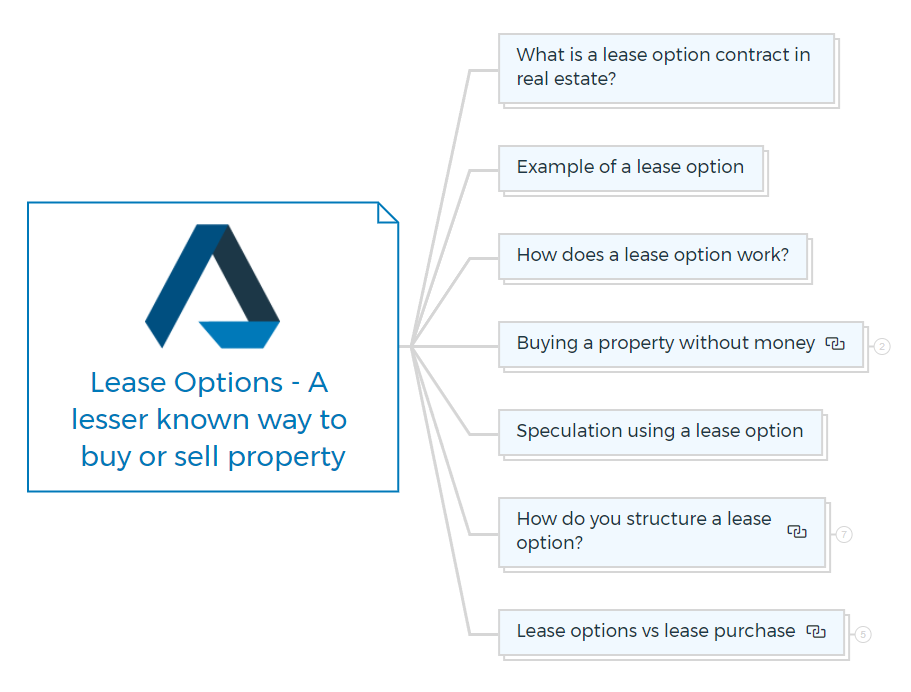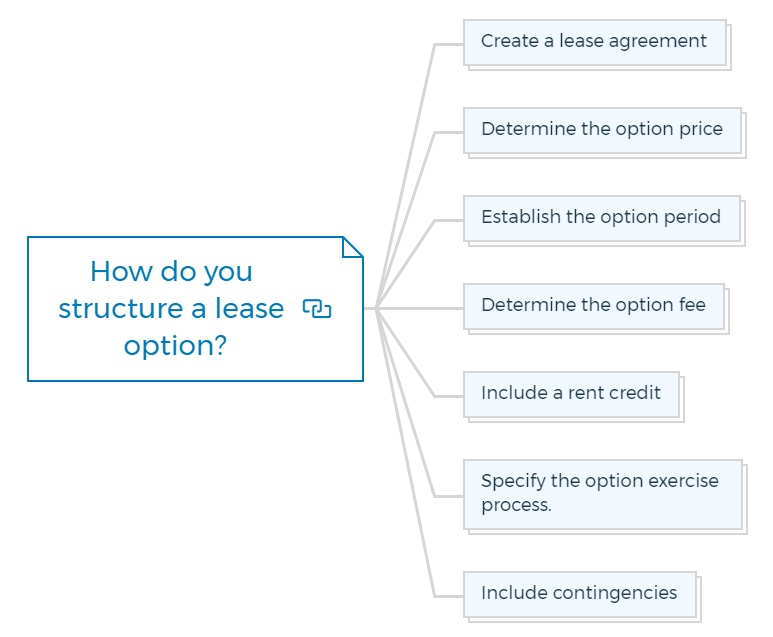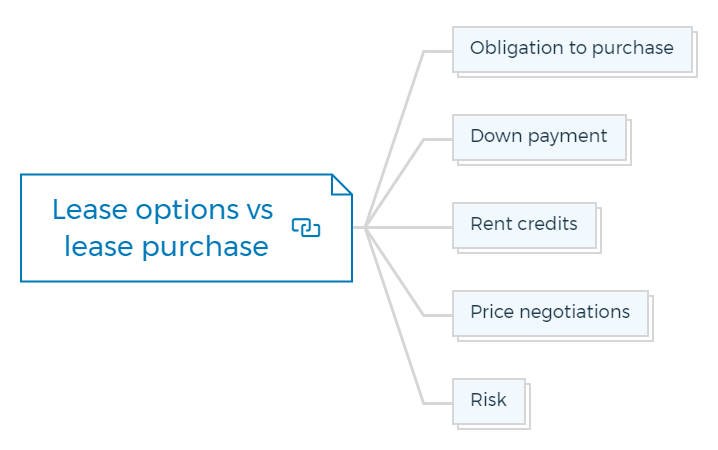Definitive guide to Lease Options - A lesser known flexible & alternative way to buy or sell property
Are you looking for an alternative way to buy or sell a property that provides more flexibility and control than traditional methods? If so, a lease option might be the solution you're searching for.

What is a lease option contract in real estate?
Lease options, often known as leases with the option to purchase, are lease contracts that allow renters to buy their homes during or after their lease.
A lease option is a property investment strategy that contains two separate parts. First is the lease, a rental contract between the current owner and the renter. The other part is the option that gives the tenant the right to buy the property in the future.
A lease option prevents an owner from selling the property during the lease term. Once the lease ends, the renter must either exercise the option to buy or forfeit it.
There are some specific provisions included in option -
- An expiration date
- A fixed price for the property
- A monthly payment amount and breakdown
- A right of assignment
Example of a lease option
Let's say that Jane is interested in buying a home but hasn't yet enough money for a down payment. She finds a property she likes, and the owner, John, offers her a lease option.
Under the lease option agreement, Jane would pay John a monthly rent for a fixed period, say two years. During this period, Jane would have the option to buy the property at a predetermined price, say $250,000.
If Jane decides to exercise her option to purchase the property at the end of the lease period, John will credit a portion of the rent she paid towards the purchase price.
For example, if Jane paid $1,000 monthly rent for two years, John might credit $12,000 towards the purchase price.
If Jane decides not to exercise her option to purchase the property at the end of the lease period, she will forfeit any money she paid towards the purchase price, and the property will remain John's.
How does a lease option work?
A lease option allows a prospective buyer greater options than a lease-purchase agreement, which mandates the renter to buy the house after the lease.
The tenant and owner agree on the home's price beforehand. Renters may purchase the residence later at the current market value.
The owner charges the renter an upfront fee for that option, generally 1% of the home's selling price. If the tenant buys the house after the lease, the fee goes to the down payment.
Buying a property without money
Buying a property without money can be challenging, but a lease purchase can be a way to achieve this goal.
The leasing option is a good strategy for investors who anticipate growing prices but don't have the cash or credit history of executing a purchase now.
You can buy a property without money through a lease purchase also.
A lease-purchase agreement is similar to a lease option, but with a lease purchase, the buyer must purchase the property at the end of the lease term.
This is a property purchase agreement with delayed closure. Most contracts require the renter to lose the earnest money deposit if the sale falls through. The lease purchase is non-assignable but has a set property price.
The renter may tie up the property and set the price for less, while the seller has a transaction that won't complete for months.

Example of Lease-purchase agreement
Let's say that Sarah wants to buy a property but does not have enough money for a down payment. She finds a property she likes, and the owner, Mike, offers her a lease purchase.
Under the lease-purchase agreement, Sarah would pay Mike a monthly rent for a fixed period, say five years. During this period, Sarah would have an obligation to purchase the property at a predetermined price, say $250,000.
If Sarah decides to purchase the property at the end of the lease period, the rent she paid during the lease period will be credited towards the purchase price.
For example, if Sarah paid $1,000 monthly rent for five years, $60,000 would be credited towards the purchase price.
At the end of the lease period, Sarah would be obligated to purchase the property at the predetermined price, regardless of whether the property has appreciated or depreciated.
If she cannot purchase the property, she will lose the money she paid towards the purchase price.
How to get out of a lease-purchase agreement?
Adding a contingency clause may let a buyer out of the lease-purchase agreement. Obtaining finance, getting approval from a lender, property inspections, and selling another property are some common contingencies.
If any of these contingencies are not
met, the potential buyer can cancel the deal and receive the earnest money back.
Note
Contingencies should be legitimate and not be included just as deal killers.
Speculation using a lease option
Speculation is the act of investing in a property with the expectation of making a profit in the future, often by anticipating changes in the market.
A lease option in real estate can be a tool for speculation by allowing an investor to control a property without owning it outright. It is simply a means of creating quick profit in a highly leveraged way.
As with any market speculation, larger earnings carry more risk.
Real estate speculators may utilise lease options to control multiple expensive houses in markets where property values rise quickly. However, speculators may lose money due to a sudden change in the market.
Get The Edge Now!
Discover the transformative power of our FREE EDGE platform and
unlock a world of opportunities at no cost!

Your Real Estate Toolkit Awaits!
Free eBooks, Courses & Feasibility Suite Trial—Join Today!
✓ Unlimited FREE Trial: Experience the full power of our Feasibility Suite with hands-on demos
—explore without limits, no time pressure & without commitment or credit card!
✓ Learn from Success: Dive into real-life case studies for practical insights.
✓ Engage, Inquire, and Innovate: Ask questions, request features, and engage in lively discussions.
✓ Showcase Your Projects and Gain Insights: Share your projects and get personalised feedback.
✓ Free Resources Galore: Access a treasure trove of free resources,
eBooks & courses to keep you informed.
✓ Exclusive Training: Enjoy members-only training to sharpen your skills.
How do you structure a lease option?
A lease option in real estate involves two agreements: a lease agreement and an option agreement. Here are the steps to structure a lease option in real estate:

Create a lease agreement
The lease agreement outlines the lease terms, such as the rent amount, lease period, and security deposit.
Determine the option price
The option price is the amount the buyer will pay to purchase the property at the end of the lease period. It should be a fair market price for the property at the time of the option exercise.
Establish the option period
The option period is the time the buyer has to exercise the option. It can be any time agreed upon by the buyer and seller but typically ranges from 1-5 years.
Determine the option fee
The option fee is a non-refundable fee paid by the buyer to the seller for the right to purchase the property at the predetermined price. This fee is usually a small percentage of the option price.
Include a rent credit
The rent credit is the monthly rent amount that will be applied towards the property's purchase price if the buyer decides to exercise the option to purchase.
The rent credit is typically a percentage of the monthly rent paid by the buyer and is negotiated between the buyer and seller.
Specify the option exercise process
The option agreement should include the process for the buyer to exercise the option, such as providing written notice to the seller and the timeline for closing the sale.
Include contingencies
The lease option agreement should include any contingencies, such as the buyer's ability to obtain financing or a satisfactory home inspection, that must be met before the sale can be completed.
It's important to have a real estate attorney review and help structure the lease option agreement to ensure it is legally binding and protects both the buyer's and seller's interests.
Lease options vs lease purchase
Lease options and lease purchases are two real estate agreements that involve leasing a property with the option or obligation to purchase it later.
Here are some critical differences between lease options and lease purchases:

Obligation to purchase
In a lease option, the tenant has the right to purchase the property at the end of the lease term, but they are not obligated to do so. With a lease purchase, the tenant is obligated to purchase the property at the end of the lease term.
Down payment
With a lease option, the tenant typically pays an option fee, a non-refundable amount that gives them the right to purchase the property later.
In a lease purchase, the tenant may be required to make a down payment, a portion of the purchase price paid upfront.
Rent credits
In both lease options and lease purchases, the tenant may receive rent credits, a portion of their monthly rent payments that are applied towards the property's purchase price. However, the rent credit amount may differ between the two agreements
Price negotiations
With a lease option, the purchase price is usually negotiated upfront, and the tenant can purchase the property at that price at the end of the lease term. With a lease purchase, you may negotiate the purchase price at the end of the lease term, which means that the tenant may not know the final purchase price until the end.
Risk
With a lease option, the tenant has less risk because they are not obligated to purchase the property if they do not want to.
With a lease purchase, the tenant has more risk because they are obligated to purchase the property at the end of the lease term, even if they no longer want to or cannot do so.
A lease option allows the tenant to purchase the property without obligation. In contrast, a lease purchase obligates the tenant to purchase the property at the end of the lease term.
Both agreements have pros and cons, and it's essential to carefully consider the terms and consult with a real estate professional before entering into either agreement.
In conclusion, lease options provide a flexible and innovative solution for buyers and sellers in the real estate market. With the proper knowledge and strategic approach, you can take advantage of the benefits of lease options to achieve your property investment goals.
If you want to learn more about lease options and other property development strategies, consider enrolling in a property development course.
FAQs

